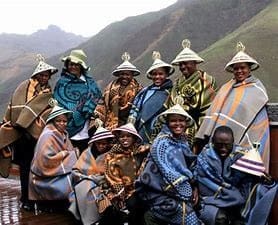Lesotho the Kingdom of Lesotho is an enclaved country within the border of South Africa. Along with the Vatican City and San Marino, it is one of only three independent states completely surrounded by the territory of another country, and the only one outside the Italian peninsula and that is not a microstate. Lesotho is just over 30,000 km2 (11,583 sq mi) and has a population of around 2 million. Its capital and largest city is Maseru. The official language is Sesotho.

Traditional Textile
The blanket’s measurements (155cm x 165cm) are smaller than the traditional blanket, making it a garment. Although the blanket can be worn across the shoulders or waist, men will pin the blanket their shoulders while women will pin it across their chest. There are three grades of blankets made. The first two use a 90:10 blend of wool and cotton respectively. While the third grade of Basotho blankets uses acrylic. Interestingly, these grades are not a reflection of the wearer’s class. The more intricate the design is, the higher the class of blanket. Lesotho does export cotton and wool, however, they didn’t use it to make the blankets. They would create patterns that were a combination of cultural and global symbols.


While there are three classes of blankets, Sotho people emphasize that no one should be judged by their class of blanket.
1st and 2nd class blankets are both made from a 90% wool:10% cotton blend. 3rd class blankets are acrylic.


Milestones & Event Markers
After the King started to use the blanket, his kingdom quickly followed suit and assimilated into their lives. For many, their first interaction with the Basotho blanket is at birth. It’s often gifted to new parents or the Serope is presented by a man to his wife when their first child is born. A Moholobela, which is a fertility blanket, is required to usher boys through their circumcision. Once they’ve reached manhood, they get another Basotho blanket known as Lekhokolo. Brides-to-be will wear a Motlotlehi blanket on their wedding day. A close companion in life, the blanket is also part of death. Traditionally, Sotho people burry their loved ones in the Basotho blanket to keep them warm in the afterlife.

The highest status Basotho blanket is the Seanamarena, which means ‘to swear by the King’. It classically features customary insignias including the mealie, which signifies wealth, health and fertility. It was introduced by Charles Henry Robertson in the early 1930s and is now owned by Aranda. There’s also the Motlatsi which was made when Prince Lerotholi was born in 2007. The only design that’s made using acrylic is known as the Khotso design.

Modern Take


More designers are working with the blanket to make contemporary clothes and products. Most notably is Designer, Thabo Makhetha. She recognised the beauty in the blankets and modernised them for a younger audience under her eponymous brand. Having been born in Basotho, she wanted to honour her heritage through her Kobo Ea Bohali ‘Blankets of Prestige’ collection.
Controversy

The Basotho blanket has made its way to international markets. And it’s been met with its fair share of praise and controversy. In 2017, Louis Vuitton used the blankets as inspiration for the 2017 menswear collection. However, the brand received some backlash for this and was accused of cultural appropriation. Makhetha commented to Times Live SA, “I think it would have been great if LV had collaborated with Basotho designers‚ crafters and manufacturers.
Weaving

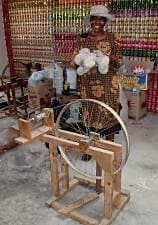
The weaving process starts with collection of fibers from Lesotho’s large herds of sheep and goats. that wool comes from sheep and mohair from goats. the coat or fleece is removed once per year, generally after the winter, when the herders bring the animals down from the mountains.
This usually happens at a communal “shearing shed” by men using shearing blades that look like a type of very heavy duty scissors. The fibers are washed then “carded” by passing them between carding combs (blocks with teeth) to separate the fibers and prepare them into a roll for spinning. 021 (600×800)The spinning wheels are operated by foot petals twisting the fibers into long strands of yarn.
After it has been spun it is sold as is or dyed in coal pots. Once dyed the yarn at the craft centers is woven into a variety of products. It was particularly interesting to see how the women standardize their designs by using a drawing behind the vertical threads, called the “warp” that the weavers use to guide the patterns, getting as creative as they like on color schemes as they, by hand, weave in the “weft”.
007 (800×597)And it does appear to be women’s work, at least at the Craft and Weaving Centers. In village, however it’s the boys who do the weaving, typically caps.
Mohair Weavings:

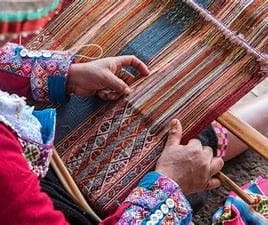
As stated earlier, Lesotho is best known for its mohair weaving tradition. Foreigners introduced weaving in the 1960s. These foreigners wanted to put to use the high quality mohair found on local goats. Foreign weaving business owners trained hundreds of women in carding, spinning, dyeing and weaving and the weaving industry grew to become the prominent craft of the country. The mohair weaving industry in Lesotho focuses on the creation of wall hangings, rugs, table runners and bags. These thick, single-ply weavings are created on simple wooden frames and are woven entirely by hand. It is a labor-intensive process. 100% mohair is used, all of which is hand spun and dyed. Mohair is sourced in Lesotho, but twine and dyes come from neighboring South Africa. A few weaving groups are also using floor looms that facilitate faster weaving. They are producing finely woven 100% mohair shawls and scarves, as well as pillowcases, bags and table runners. there are roughly 7 mohair-weaving businesses in Lesotho, and Basotho women run all but one. Hundreds of women are employed by this industry which is targeting tourists. But this market is limited, as Lesotho has done little to court international visitors, and the weaving groups are looking for more export connections.

Sheepskin Products: Many foreign residents are great fans of Lesotho’s warm sheepskin slippers. For cold nights in the mountains they are ideal. There is a growing industry, although still quite small, that produces these slippers. Sheepskin has historically been used for clothing, but the slippers are a new innovation, which have also been quite popular with locals.

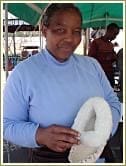

Leatherworks: Like the sheepskin slippers, leather is not new to Basotho, but is now being used in innovative ways by a few young designers to target local needs. A few leatherworkers are creating various sandal designs with locally sourced leather. Some sandals in the country are also adorned with sections of cowhide across the top, as well. They are popular shoes with local women.
Jewelry: As stated above, clay bead jewelry is a long-standing tradition in Lesotho. Today, artisans are creating sterling silver jewelry and cow-horn jewelry. Now, in Maseru, one can see silver earrings that depict traditional rondavels, cow-horn pendants and earrings with mountains painted on them, and other innovations. Again, these products have a wide local appeal and it is common to see them being worn by local women. Tourists also support these artisans.


Mokorotlos – Basotho hats

The second-most noticeable earmark of Basotho style after the blankets is the hats. The most commonly seen by outsiders is a conical hat with a knot at the top. A mokorotlo is so important to the country that it is on the Lesotho flag and license plates. The straw hats are made by women in the villages and are designed after the similarly conically shaped Mount Qiloane. It is traditionally worn only by men, but in modern times there are female versions of the design.
Tie Dye & Batik: Although tie-dye and batik are very new practices in Lesotho, one business, House of Africa, is making an effort to introduce it to the country. House of Africa is now beginning to create comparable quality for reasonable prices. Alongside seshoeshoe dresses, it is now common to see local women wearing West African-influenced dresses.
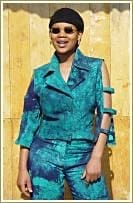
Bags: Some young designers are putting large international garment factory scraps to good use and creating unique and trendy handbags. One artist named Manyo has found a huge number of customers in some of Lesotho’s tourist lodges, but also has a growing clientele of local women. As Basotho women become more fashion conscious and have more disposable income.

Textile manufacturing in Lesotho
Lesotho has a single vertically integrated spin-yarn dye-weave textile mill that specialises in the manufacture of denim fabrics. 100% of the OE yarns are utilised in-house to make denim fabrics; 30% of the RS yarns are used in-house and 70% are sold in South Africa (mainly), Swaziland and Mauritius.

Denim jeans manufacturing in Lesotho
Lesotho’s jeans manufacturers make approximately 23.3m pairs of typical (average styled) jeans a year. For four of these South African orientated plants wet finishing is not undertaken in Lesotho due to the fact that there are no publicly accessible effluent treatment plants that can reprocess denim water wastes. From time to time some of these plants also make limited volumes of cargo pants, chinos and industrial workwear.
Woven garments manufacturing in Lesotho
There are four Lesotho garment plants which specialise in making woven garments – that do not fall into the categories of denims or workwear. One firm makes higher end garments destined for two of South Africa’s premium apparel retailers; another two only make shirts typically worn by school students in Southern Africa. It must be noted that a number of Lesotho’s traditional knit garment manufacturers occasionally make limited amounts of woven workwear (e.g. Shinning Century, CMT Trading, Leo Garments). Long River has the ability to make knit garments too.
Knit garments manufacturing in Lesotho
The Lesotho knit garment industry is the largest component of Lesotho’s apparel industry. A diverse range of products are made. From commodity cotton t-shirts, dresses, tracksuits, through to sportswear, Most of these orders are given to Lesotho plants by a number of garment design/sourcing houses based in (mainly) Durban or Cape Town; only a limited number of orders are given directly by the Southern African retailers.
Article By Harshika Sapra
Bibliography
www.britannica.com
www.tralac.org
www.csmonitor.com
tdsblog.com
lesotho-blanketwrap.com
www.africancraft.com

